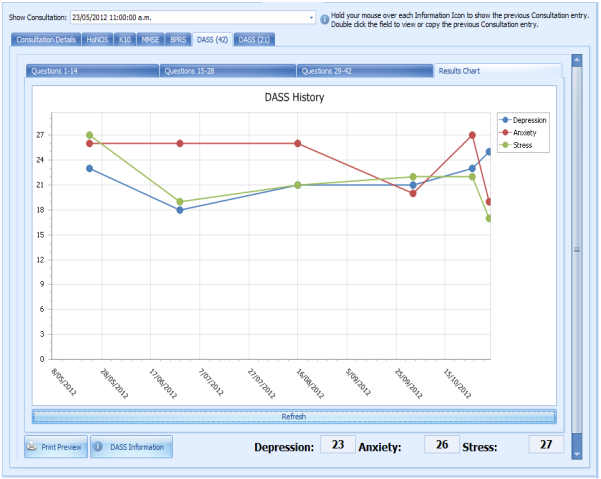To display new DASS (42 or 21) information entered into a client's record, the information must first be saved and then the chart refreshed.

NOTE Tests with a score of all zeros will not display on the graph, as it is assumed that a test with a zero score has not been completed.
- In Client Details > Consultations > [Selected Appointment Date] enter in the DASS scores.
- Click Save to save the Client Record.
- Go to the Results Chart tab.
|
Field |
Description |
|---|---|
|
Refresh |
The chart should update with the new score information. |
|
Print Preview |
View the chart and results information and either print or save. |
|
DASS Information |
Acknowledgement of the source for the DASS information used in Bp Allied. |
The following provides more information about the calculation logic used by these clinical tools, which may assist in assessing suitability for use at your practice.
Depression Anxiety Stress Scales 21
Description: Depression Anxiety Stress Scales (DASS21) score is designed to measure the three related negative emotional states of depression, anxiety, and stress.
Source: Developed by the University of New South Wales, Australia.
Calculation: The DASS score is calculated from 21 questions answered by the patient. The answer to each question is given a value. Values are added to give a separate sum score for depression, anxiety, and stress.
Depression Anxiety Stress Scales 42
Description: Depression Anxiety Stress Scales (DASS42) score is designed to measure the three related negative emotional states of depression, anxiety, and stress.
Source: Developed by the University of New South Wales, Australia.
Calculation: The DASS score is calculated from 42 questions answered by the patient. The answer to each question is given a value. Values are added to give a separate sum score for depression, anxiety, and stress.
Kessler Psychological Distress Scale
Description: The Kessler Psychological Distress Scale (K10) measures non-specific psychological distress.
Source: Developed in 1992 by Professors Ron Kessler and Dan Mroczek. Read more information on the K10 and usage in Australia.
Calculation: The K10 score is calculated from 10 questions answered by the patient. Each answer carries a weight from 1 to 5; the final score is the sum of all answer values.